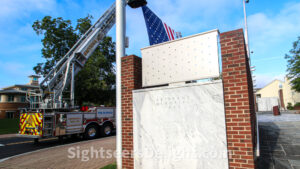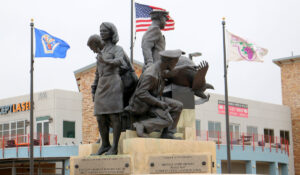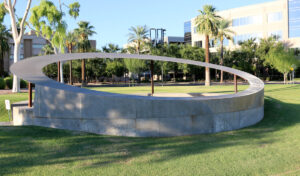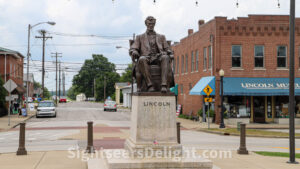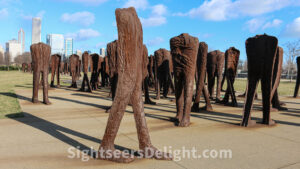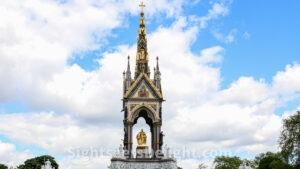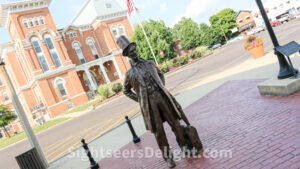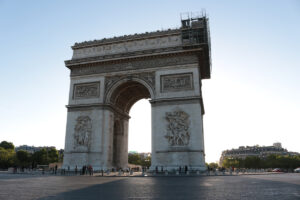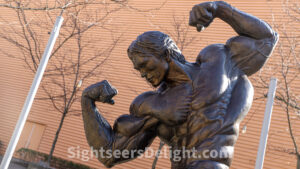The 20th Century Veterans Memorial in downtown Smyrna, Georgia, was dedicated on October 12, 2002. A Veterans Memorial Committee chose the site for the monument in August 1999, and it was expected to be finished by Labor Day 2001 at a cost of between $1 million and $1.5 million. In March 2000, the Smyrna City Council and the Smyrna Downtown Development Authority signed off on the plan despite opposition from nearby residents. However, work was delayed about a year, and officials broke ground on the project in January 2002. Then-Gov. Roy Barnes, U.S. Rep. Johnny Isakson and U.S. Sen. Max Cleland were among the dignitaries at the memorial’s dedication. A mix of private and state money funded the $650,000 memorial.
30080
The 9/11 Flight Crew Memorial was born out of American Airlines Flight Attendant Valerie Thompson’s desire to honor the crewmembers killed on the planes hijacked on Sept. 11: American Airlines flights 11 and 77 and United Airlines flights 93 and 175. Her dream became reality when the monument was dedicated on July 4, 2008. Based on a design by Bryce Cameron Liston of Salt Lake City, Utah, and sculpted by Dean Thompson, the memorial features bronze sculptures of two pilots, two flight attendants and a child who represents the traveling public. The memorial’s base stands 18 feet tall. The names of crewmembers on the four flights are engraved on slabs of granite surrounding the base.
76051
Located at the Wesley Bolin Memorial Plaza near the State Capitol in Phoenix, the 9/11 Memorial in Arizona was unveiled on Sept. 11, 2006. The memorial is often — and perhaps best — described as a circular plan with a flat inclined metal ring. The memorial opened to some controversy. The controversy centered on a number of quotes engraved into the ring, including “Congress Questions Why CIA and FBI Didn’t Prevent Attacks” and “You Don’t Win Battles of Terrorism With More Battles.”
The Abraham Lincoln statue in the public square in Hodgenville, Kentucky, was dedicated on May 31, 1909. Adolph Alexander Weinman sculpted the six-foot-tall statue, depicting Lincoln sitting in an Empire-style chair. The marble foundation features stars inlaid on a Greek fret band, and the statue’s eastern facade spells out “Lincoln” in bronze letters. Lincoln’s son, Robert Todd Lincoln, attended the statue’s dedication, and Lincoln’s sister-in-law, Mrs. Ben Hardin Helm, unveiled the statue.
42748
Agora is an art installation of 106 headless and armless iron sculptures. Polish artist Magdalena Abakanowicz designed the installation, which is located at the south end of Grant Park. In 2006, the Chicago Park District brought the work to Chicago as a permanent loan from the Polish Ministry of Culture. While similar installations have been constructed worldwide, Agora is among the largest.
60605
The Albert Memorial, located north of the Royal Albert Hall in Kensington Gardens, London, was constructed in honor of Prince Albert, Queen Victoria’s dear husband, who passed away in 1861. Sir George Gilbert Scott designed the ornate pavilion, which stands at a height of 176 feet (54 m) and resembles a Gothic ciborium over the high altar of a church. Inside the pavilion, there is a south-facing statue of Prince Albert. It took more than ten years to construct and was funded by public subscription, costing £120,000 (roughly £10 million in 2010). The Queen inaugurated the memorial in July 1872, and the statue of Albert was ceremonially “seated” in 1876, and it was classified as Grade I in 1970.
Sculptor John McClarey of Decatur, Ill., created a statue depicting Lincoln in September 1858 when he arrived in Hillsboro, Ill., while running for Senate. The statue, located near the Montgomery County Courthouse, was unveiled in August 2009.
62049
The city of Arcade, Georgia, dedicated its Veterans Memorial during the city’s centennial celebration on Aug. 17, 2009. It honors everyone who fought for the country, including those in “the Gulf wars,” the Athens Banner-Herald reported.
30549
Construction on the Arc de Triomphe de l’Étoile started in 1806 and lasted until 1836. Located in the Place Charles de Gaulle and at the western end of the Champs-Élysées, the Arc honors French soldiers who died fighting for France during the French Revolutionary and the Napoleonic wars. The Tomb of the Unknown Soldier from World War I is beneath the Arc, which was the tallest triumphal arch in the world until 1938.
The statue of Arnold Schwarzenegger sits outside the Greater Columbus Convention Center, where it has stood since 2014. The bronze sculpture was originally erected outside the Franklin County Veterans Memorial in 2012, before being relocated and rededicated to its current location. Schwarzenegger, Ohio Gov. John Kasich, and Columbus Mayor Michael B. Coleman attended the ceremony.

